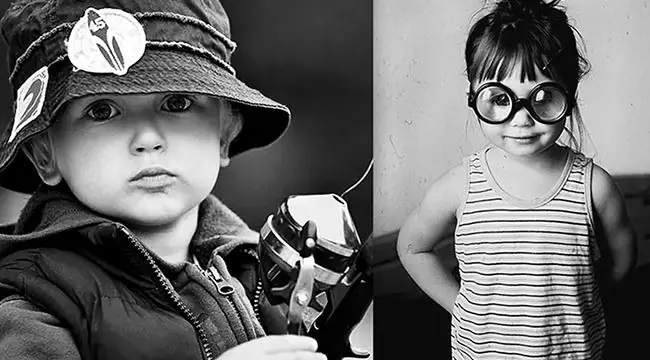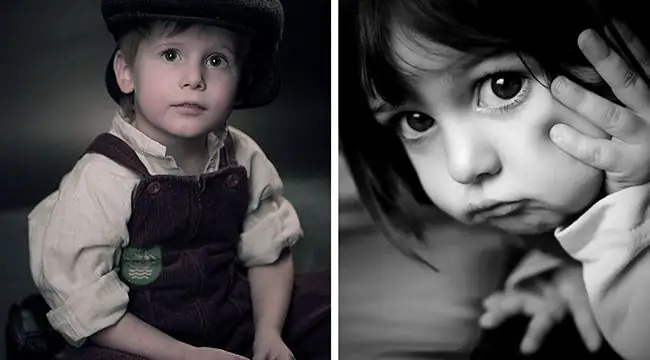- Author Adrian Jeff [email protected].
- Public 2023-12-17 05:06.
- Last modified 2025-01-24 14:09.
Glenn Doman's technique
“… If we stuff our children's heads with all sorts of nonsense, it is hardly worth expecting smart speeches and actions from them. Therefore, we must provide them with accurate, clear and unambiguous information,”wrote Glenn Doman in his works.
I want my child to be the best, the smartest, the most developed, the happiest.
I want the kid to be able to realize those dreams that we failed to realize.
I want my child to be successful in life, despite the diagnosis made by the doctors.
I want to create the best conditions for my child to develop.
Such desires of parents can be considered natural. What loving mother doesn't want the best for her children?
An entire industry has been created to meet parenting needs. Various kinds of early development centers have appeared, methodological manuals and materials, educational games have been developed, thousands of popular scientific publications on child psychology have been published with accessible recommendations of psychologists on how to raise children to obtain brilliant results, a huge number of sites, forums have appeared on the Internet, dedicated to the secrets of educating the younger generation.

In the sea of information, with sharply differing responses to the application of a particular technique, parents are invariably invited to make their own choice, and therefore, to bear responsibility for it. At the same time, parents cannot always reasonably, realizing all the disadvantages and advantages of the chosen method of raising their own children, make a decision. They are often wrong.
They do not see the main thing - the innate characteristics of their children. Blinders interfere in the consciousness, which is slagged with generally accepted attitudes, personal experience and knowledge, perception of reality through oneself.
System-vector psychology of Yuri Burlan assumes a fundamentally different approach - awareness of oneself, the inner world of other people through eight-vector analysis, which allows you to get an accurate answer in matters of education.
Thus, a systematic analysis of Glenn Doman's method of early development, popular all over the world since the 1960s, contributes to a holistic view of the benefits / harms of the method and helps parents to determine what is good for a particular child and what is evil.
Basic postulates
Some authors of articles on early development call Glenn Doman an American pediatrician, others - a neurophysiologist, neurosurgeon, Glenn Doman himself calls himself a physiotherapist. He is known for the fact that he founded the Institute of Accelerated Child Development and developed a unique method of developing the mental abilities of children at an early age.

When Doman started his career, he was involved in the treatment and rehabilitation of children who had serious brain injuries and lesions of the central nervous system. I must say that Doman has made some progress in the recovery of his patients (stimulation of "reserve" brain cells by external stimuli led to the fact that the sick children moved and started talking). Then he came to the following conclusions:
1. By influencing one of the senses, it is possible to increase the activity of the brain as a whole.
2. Stimulating the vision of the immobilized child with the help of special cards promotes the fact that he begins to move, learns to read and math.
3. The more intense the load on the child's brain in the first years of his life, the better his intellect will develop.
4. Learning is effective only during the period of human brain growth - up to about 7.5 years, while the most intensive growth occurs in the first three years of a child's life.
5. At an early age, the child does not need additional motivation to learn. He can master a lot - from a foreign language to mathematics.
6. Physical development stimulates mental development.
The main directions of the methodology of Glenn Doman
There are four main directions in teaching a child according to the Doman method.
First, it is supposed to physically develop the baby, giving him the opportunity to move freely from birth, do without swaddling, use arenas, and engage in various gymnastic exercises.
Secondly, in his book "Harmonious Development of the Child" Glenn talks about the importance of forming a system of encyclopedic knowledge with the help of "bits of intelligence" - cards with pictures, divided into categories.
“The human brain is the most perfect computer, the more facts it knows, the more conclusions it can draw. If we stuff our children's heads with all sorts of nonsense, it is hardly worth expecting smart speeches and actions from them. Therefore, we must provide them with accurate, clear and unambiguous information,”he wrote in his works.

Third, learning to count is best done by showing the child cards with red circles. Dots are perceived by a child better than abstract numbers.
Fourthly, to learn to read, you need to use cards with words written in big red letters. The first words are taken from the immediate environment of the baby, then the vocabulary is constantly expanding.
In a dispute … a dispute is born
For more than fifty years of application, Glenn Doman's method has acquired both active supporters and zealous opponents.
Opponents of Glenn Doman reproach his method for the fact that with his approach the child is a "passive object of learning" who knows a lot, but does not know how to use the knowledge gained. They point out that for learning Russian, learning to read by words, and not by warehouses, does not justify itself. In English, it makes sense to memorize each word separately, but for us it is enough to know the rules of the Russian language.
Cited as evidence that a baby's head can be diligently filled with adult information, but this does not affect his thinking ability, a documentary about the Doman Institute for Human Development - "Smart babies" Discovery Health. It tells the story of a 17-year-old boy who, as a child, knew, for example, many names of aircraft models, and at the age of 17 he did not recognize a single model from the "children's" cards shown to him by journalists.
Moreover, some researchers say that in America Doman's methods "failed" and as another fashionable "heresy" appeared in Russia in the 1990s. Young inexperienced parents, newly minted psychologists quickly adopted Doman's books for the realization of their own goals (“to brag to other parents,” “so that the child does not grow up as cattle,” etc.), and not at all for the good of children.

Meanwhile, the Doman Method attracts parents with a clear logical system and promising amazing results. In addition, all parents are pleased to think, in the words of the author of the methodology, that "every child at the moment of his birth has a higher mental potential than that demonstrated by Leonardo da Vinci."
And here they are invited to invest an invaluable parental contribution to the successful future of their child, to reveal the endless possibilities of children, not to drive the child's education into those frameworks that are caused by our ideas about education and other delusions.
Reviews from parents and not only
The most revealing, in contrast to the discussion of specialists, often turning into a showdown and into the plane of personal hostility, is the real parental experience of using the Glenn Doman's methodology.
However, even here we fall into a mess - the reviews are too different:
“We started working with my son at 6.5 months and started with points and fruits. He looked at the first ten points, but then he simply turned away when he saw the points, and, on the contrary, showed interest in the pictures."
It is not surprising, because a beautiful picture is important for visual children, and the dots are monotonous.

“Markus was about 1 year old, and we started using flashcards to teach counting and to form encyclopedic knowledge. I acted strictly according to the method (5 cards, 1 second to show each picture), but several weeks passed and my zeal faded away.
At the age of 2.5, he sorted the cards himself with great interest by category or by some attribute, for example, edible-inedible. I noticed that Marcus likes to look at the details on the cards, especially if they show vehicles. At 3 years and 8 months, he likes to look at cards on a computer monitor."
Anal children, especially boys, like to examine in detail pictures, objects, especially those related to the "male" areas of knowledge, and sort everything out, put it in boxes.
“When my son was diagnosed with CRD in the maternity hospital, I decided for myself that I would do everything for the baby to develop fully. And Glenn Doman's book "Harmonious Development" in 1996 helped me a lot. I drew and pasted all the cards myself. Six months later, all diagnoses were removed. Now he is 15 years old, he studies at the lyceum, is a member of the regional football team and is a diploma in the field in dance programs."
However, for the sake of her son's brilliant success, my mother had to sacrifice her personal life. There was simply no time or energy left for her.
“We started to“read”Doman from birth. At the age of 7-8 months, they surprised others, unmistakably finding familiar words, but as soon as the pictures were changed, the child was lost."

An anal baby by nature has an encyclopedic memory, he can remember pictures, but any changes - and that's it, a stupor arises.
“I was trained to read and count by the age of four, and at the age of seven I entered the third grade. In general, it was easy to study later, but there were problems in communicating with classmates who were two years older. At the same time, I can say that in the end I did not become a great scientist, I studied unevenly. Many things were easy, and I didn’t make an effort to master them. But on the other hand, where it was necessary to make efforts, I did not do it, since I did not have such a habit."
Feedback from a person who has experienced the impact of Glenn Doman's methodology. Problems in communication, lack of skill to gain knowledge through work and sweat. At the same time, it is difficult to disagree with him that “teaching a child to“be a good person”is much more important than teaching him to be a genius. But here neither Doman's technique will help, nor game techniques”.
System parsing
The system-vector psychology of Yuri Burlan differentiates children according to their innate properties. Properties are given to us by nature, but their content depends on the living conditions of a particular child.
Parents at the first and most important stage for personality development provide the best conditions for realizing their natural potential or do not. It is clear that early development is in any case better than parental connivance and indifference to your child, but let's try to understand the essence of Glenn Doman's early development method.
For whom is it useful and for whom does it work?
Luck principle
First of all, it works for children born with a visual vector. Other children have different sensitive areas. For example, in dermal children, the erogenous zone (the most sensitive) is the skin, in olfactory organisms - the vomeronasal organ, in sound specialists - hearing, etc.
Knowledge of the vectors allows you to influence pointwise and more effectively on the development of the child. So, a massage course is a good stimulation for the development of the skin baby. The dermal baby after it takes a noticeable step in its development.
And for the visual, there is nothing better than visiting beautiful places, looking at bright beautiful pictures, drawing for pleasure.

Without a clear understanding of the inner world of a child, we act at random, so even Glenn Doman's simple advice does not work for all children. For example, children respond very differently to learning through flashcards and show different results.
For a dermal child, the principle of novelty is important, so he takes the first lessons with a bang, mom sees his positive reaction. But a little time passes and he gets tired of the monotony of classes and the monotony of cards, he gets distracted, switches to something else.
I must say that the skin mother is also bored with classes with cards, according to the strict method prescribed by Doman. She starts looking for options, coming up with new ways to use it. But anal mothers will try to follow all the recommendations carefully so that everything is as in the original - perfect.
For an anal child, a quick display of cards will not do anything, he needs to consider the card for a long time and thoughtfully, to clarify the incomprehensible.
Thus, the approach of Glenn Doman can have some effect, ie, the result, if the child has a visual vector and the mother "adjusted" the technique according to the characteristics of her baby. But…
Everything has its time
Parents need to keep in mind that learning with Glenn Doman's flashcards is not something that should be done with a child of this age. For him, at an early age, it is more important to master the world around him with his own hands, rather than sitting obediently in a corner and going through cards.

Interaction with adults is a plus of classes, however, the impact mainly occurs on the intellectual zone, and the main thing at an early age is socialization. Carrying out classes with children in kindergarten using Glenn Doman's cards can only be an addition to the organization of cognitive activities, nothing more.
If the child's educators are zealous in his physical development, he acquires a pile of muscles, if in the intellectual one - a lot of knowledge, but the child becomes a person only when educated and in live communication with peers.
Hence, we see in the responses of parents and the grown-up children themselves, with whom they studied according to the method of Glenn Doman, regret that life does not bring such satisfaction as one might have expected. Difficulties in communicating and building relationships with other people are also noted. Time wasted. If intellectually they were geniuses in childhood, and even now they are distinguished by a high level of intelligence, then socially, many "Domanov children" remained on the brink of "Mowgli" - they are frightened by the collective.
You need to understand that a child needs full-fledged communication, interaction and not necessarily a game, it can be joint work, crafts, any activity in a team. Pictures of what life is are not enough to know what life is. The child will then adapt not to people and animals in the pictures, but to real and living ones.
The same can be said about children with cerebral palsy. For them, this technique can become a way to look into the world, but only in a way. If possible, they need to be socialized in society. As time and effort go, take them to classes with dolphins, horses, do not let them become isolated and create for them, albeit small, but their circle of friends. There will never be a better teacher for anyone than life itself and the people around him.




